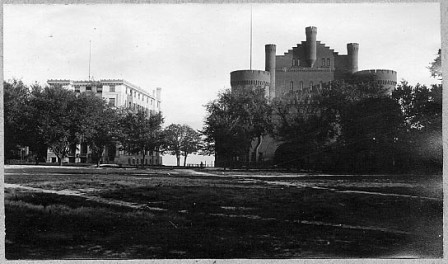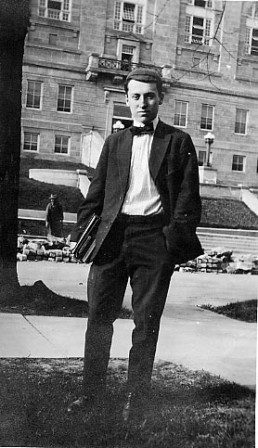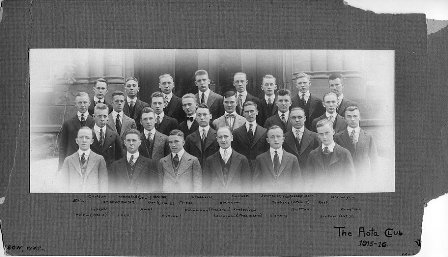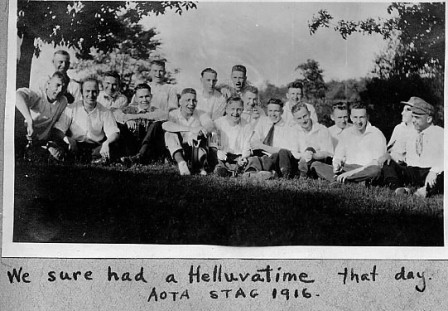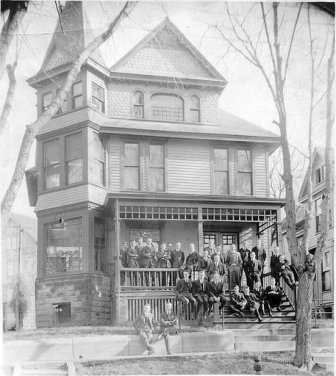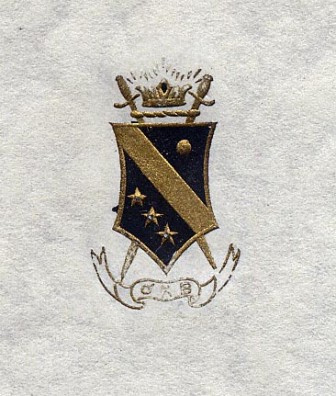Psi Chapter History - 1915-1916
Founding
Theta Chi • 1915-1916 • 1917-1937 • 1941-1949 • 1950-1964 • 1965-1984 • 1985-2005
The origins of Psi Chapter of Theta Chi Fraternity lie in a meeting on the afternoon of Sunday, April 11, 1915, at the old YMCA building at 740 Langdon St., Madison. There a group of University of Wisconsin students — Frederick W. “Fritz” Fuhrmann, J. Bernard Johnson, Milton H. Button, Elmer C. Priewe, William G. Dormeyer, Ralph Friess, and Arno R. Langjahr — met to form “an organization which would perpetuate certain ideals of fraternity, democracy, and high standards of manhood which these students possessed.”
|
|
|
The campus YMCA, left, and Red Gym. |
earlier that school year to establish a new fraternity at the university. This was not due to any spontaneous decision, but was the result of careful deliberation and study of fraternity conditions on campus.1
All the members returned to the university that fall, but owing to unforeseen difficulties were not able to room at the same house, as previously planned. At this time no definite written constitution or by-laws had been drawn up, for it was felt that the organization should have more charter members before this was attempted. Accordingly, seven more students with like ideals and standards were found and inducted. But one of the greatest drawbacks to rushing students was the lack of adequate facilities for becoming acquainted with new men, where all the members could meet a candidate at one time.
The group had now reached the point where it could safely take up a small house, and Elmer Priewe, acting in the capacity of a house committee, was able to lease the Ramsay house (so called after its landlord) at 424 N. Charter St., for six months. About a dozen men moved in after Christmas vacation of the 1915-16 school year. The establishment of such rooming and fraternity houses was encouraged by the fact that between 1885 and 1926 the university had no dormitories for male students. During the 1915-16 year, 23 percent of the male students belonged to fraternities.
Up to this time the group still had no name. It began to be informally called the Ramsay Club, and soon this name was officially adopted. It was then that a constitution and by-laws were drawn up, and the first officers elected; Fuhrmann became the first president.2 Rush meetings were held every other Saturday evening. Many of the men who joined had been bid by other fraternities but were dissatisfied with their standards.
|
|
|
Psi Chapter founder Fred Fuhrmann, wearing the requisite freshman beanie cap at the University of Wisconsin, 1914-15. |
Such great strides were made that semester in membership and organization that the need for a bigger house began to be felt. A committee was formed and found a large house at 625 N. Frances St., with accommodations for 24 men, that would bring them into the fraternity district.
|
|
|
The
Aota Club, 1915-16. Aota was the
earliest predecesso |
The next step in the club’s history came about as a means to safeguard the signing of the lease on the new house. On May 12, 1916, the club, 25 members strong, incorporated under the laws of the State of Wisconsin as the Aota Club “in order to make the society more permanent” and, as the original articles state, “recognizing that in the University of Wisconsin there are certain social and educational advantages to be gained from close association and personal contact of certain men engaged in the acquirement of an education; and that such advantages can be better obtained by a close union and co-operation of these men.” These words were not puffery — the members’ grade point average at the end of that semester topped that of any social fraternity campus.
The name Aota was chosen because it sounded like a Greek letter without actually being one — an accurate description of the club’s relationship with the Greek-letter fraternities on campus. Any male student “of good moral character” was eligible to become a charter member with the approval of the three incorporators — Lyel N. Jenkins, Reider R. Frederixon, and Marvin C. Goul — and upon attending the charter meeting at the Ramsay house on May 22, 1916, at which time the officers of the club were elected and the by-laws established; Arno Langjahr was elected the first president of Aota Club.3 Later members were to be admitted upon the unanimous vote for all active members.
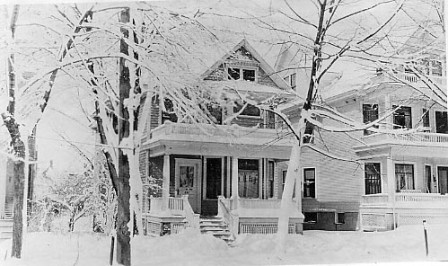 |
|
Aota Club headquarte |
No sooner had the Aota Club been incorporated and the new house leased that the members began to feel that the club was well enough organized to evolve into a Greek letter fraternity, but the matter remained undecided. During the summer, as the house was being furnished for occupancy that fall, several members continued to insist that the club was ready to carry out the original object of Fuhrmann and the other founders.
The club’s first newsletter was published that summer of 1916, derived from letters from all the brothers mailed to the secretary. It was a successful experiment and became an early tradition of the fraternity.
|
|
|
Aota Club outing, 1916. |
A special meeting of the club was held on September 28, 1916, to decide its future.4 Dean of Men Scott H. Goodnight, a valued friend from the previous semester, urged them to go ahead with their plans. The 31 members voted, with one dissent, to re-incorporate as a local Greek-letter fraternity, “realizing … that greater advantages could be gained by closer association with the fraternities of the university, and that [the Aota Club’s] purposes and principles could be better promoted through such contact.” A committee consisting of Fuhrmann, Alfred H. Burton, and Ned R. Ellis was appointed to carry out the necessary work for such a change.
Harold W. Browning, an alumnus of Eta Chapter of Theta Chi at Rhode Island State College who was now a fellow in botany at the University of Wisconsin, had befriended the club the previous semester, and aided the club members in their reorganization as a fraternity.
The committee wrote the traditions, history, and ideals of the Aota Club into a ritual, and revised its constitution and by-laws. The name Alpha Sigma Tau was derived from the initials of a motto Fuhrmann suggested: “Always Stick Together”. Democracy, Knowledge, and Brotherhood became the fraternity’s principles, and gold and black its colors. A badge and coat of arms were also designed, the latter prophetically featuring crossed swords.
The articles of incorporation were amended on October 3, 1916, to change the name from Aota Club to Alpha Sigma Tau. The 29 charter members were apparently unaware that a sorority of the same name already existed (the nearest chapter, at the Milwaukee Normal School, became inactive in 1913).
|
|
|
Alpha Sigma Tau Fraternity |
Dean Goodnight gave his endorsement to the new fraternity when he agreed to be its faculty advisor. “I know them to be a thoroughly agreeable group of students,” he told The Daily Cardinal. “They are possessed of the right kind of ambition to maintain a high status in scholastic and social life. The organization is thoroughly democratic and has leaders of discretion and ability. I congratulation Alpha Sigma Tau upon the business-like procedure of its organization and wish it success and prosperity.”
|
|
|
The coat of arms of Alpha Sigma
Tau Fraternity |
Not having been socially active before, Alpha Sigma Tau was quick to establish itself in the Greek system that fall, playing interfraternity basketball and holding its first dance that November. Once again, its members had the highest grade point average at the end of the semester of any fraternity on campus.
Step by step the new local advanced, and it was not long until it became the ambition of the members to affiliate with a national fraternity, knowing that “affiliation with a national fraternity would greatly benefit [their] organization.” On October 23, 1916, the members decided that Alpha Sigma Tau should petition a suitable fraternity for a charter. With this end in view, a committee consisting of Dormeyer and Alfred H. Burton was appointed to investigate national fraternities. Although Harold Browning was not on this committee, his influence as a member of Theta Chi was no doubt pivotal in their choice. After several nationals were carefully considered, on Nov. 3, 1916, three alumni members of Theta Chi investigated Alpha Sigma Tau for the Grand Chapter of Theta Chi.5
1 What were those conditions? One can speculate. Fuhrmann, the leader of the core group, did not drink alcohol. Even though all Greek system social events of that day were officially dry, and monitored, he may have been dismayed by general alcohol use and abuse by fraternity members in their everyday lives. But Fuhrmann was only one of the founding members, and in none of the early histories of the fraternity, including Fuhrmann’s speech at the installation dinner, was a non-alcoholic policy mentioned as a founding principle.
2 Julius L. Wendstadt, Vice President; Elmer Priewe, Secretary; and J. Bernard Johnson, Treasurer.
3 Lyel Jenkins, Vice President; Alfred Burton, Secretary; and Marvin Goul, Treasurer.
4 Since Psi Chapter originated as a local fraternity, this date, September 28, 1916, should be regarded as the founding date of Psi Chapter, not 1918.
5 Fred S. Putney (Zeta ‘05), Harold W. Browning (Eta ‘14), and Carle M. Bigelow (Eta ‘12). Putney was an honorary fellow in the University of Wisconsin College of Agriculture. Browning returned to Rhode Island State College in 1920 and eventually became Dean of Men, Dean of the College of Arts and Sciences, and Vice President.
